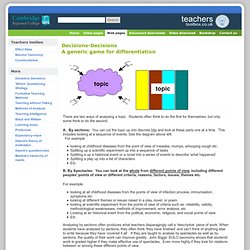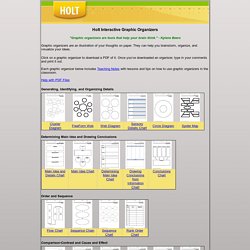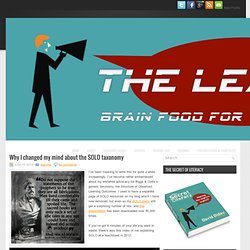

Toets-wijzer-scoor-hoger. Teachers toolbox - Decisions-Decisions. There are two ways of analysing a topic.

Students often think to do the first for themselves, but only some think to do the second. A. By sections: You can cut the topic up into discrete bits and look at these parts one at a time. This includes looking at a sequence of events. See the diagram above left. Looking at childhood diseases from the point of view of measles, mumps, whooping cough etc . B. For example: looking at all childhood diseases from the points of view of infection process, immunisation, symptoms etc looking at different themes or issues raised in a play, novel, or poem looking at scientific experiment from the points of view of criteria such as: reliability, validity, methodological weaknesses, methods of improvement, error analysis, etc Looking at an historical event from the political, economic, religious, and social points of view.
Interactive Graphic Organizer. Holt Interactive Graphic Organizers "Graphic organizers are tools that help your brain think.

" - Kylene Beers Graphic organizers are an illustration of your thoughts on paper. They can help you brainstorm, organize, and visualize your ideas. Click on a graphic organizer to download a PDF of it. Once you’ve downloaded an organizer, type in your comments and print it out. Each graphic organizer below includes Teaching Notes with lessons and tips on how to use graphic organizers in the classroom. Help with PDF Files. HookEDHOTMapsWordPoster_A3_1. Create a New Rubric. Jigsaw Activities. Explanations: Top Ten Teaching Tips. “There is no pleasure to me without communication: there is not so much as a sprightly thought comes into my mind that it does not grieve me to have produced alone, and that I have no one to tell it to.”

Michel de Montaigne quotes (French Philosopher and Writer. 1533-1592) Very recently I responded to a question about great teaching by Joe Kirby (read this excellent blog post) with the answer that explanations, questioning and feedback were the holy trinity of teaching. I have written about questioning and feedback at length, but I have never written about teacher explanations. I thought about why and I considered that part of the problem is that explanations are so integral to everything that we do that we quickly learn our style and then explain away on autopilot pretty much for the rest of our career. I would argue that we need to reflect upon whether we are maximising the effectiveness of our explanations.
Top Ten Tips: 1. 2. 3. 4. 5. 6. 7. 8. 9. 10. Further reading: Lesstofplanning. I’ve asked before why students don’t remember what they’ve learned: how we design instruction, the curriculum and assessment plays a large part.

On first discovering cognitive science, Kris Boulton said it was “like being given the cheat codes to intelligence”. The models of memory and the mind in seminal texts like Dan Willingham’s Why Don’t Students Like School, the models of how we learn and the insights for instruction: this research has a lot to offer teachers. Touchpaper problem #7 is about retaining content in long-term memory. If cognitive scientists are correct, that ‘if nothing has been retained in long-term memory, nothing has been learned,’ this is a key issue for teachers.
Our team (Helene, Mark, Tim, Ben, Lucy, Jackie and I) tried in the touchpaper working party to turn what we know from cognitive science into what teachers can do about it, to work out exactly what we still need to know. Getting feedback right. Neuromyths in Education: Prevalence and Predictors of Misconceptions among Teachers. Introduction There is widespread interest among teachers in the application of neuroscientific research findings in educational practice.

Neuroscientific research has received a lot of attention since 1990–2000, which was declared the “Decade of the Brain” in the United States. Yet, the field of neuroscience is complex and the accurate transfer of research findings to the classroom is often difficult (Jolles et al., 2005; Devonshire and Dommett, 2010; Ansari et al., 2011). This gap between neuroscience and education has enabled many misconceptions about scientific findings to occur (Goswami, 2006). In 2002, the Brain and Learning project of the Organization for Economic Co-operation and Development (OECD) drew international attention to this phenomenon.
Although neuromyths are incorrect assertions about how the brain is involved in learning, their origin often lies in genuine scientific findings. Materials and Methods Participants Procedure. Why I changed my mind about the SOLO taxonomy. I’ve been meaning to write this for quite a while.

Increasingly, I’ve become rather embarrassed about my erstwhile advocacy for Biggs & Collis’s generic taxonomy, the Structure of Observed Learning Outcomes. I used to have a separate page of SOLO resources on my blog which I have now removed, but even so my SOLO posts still get a surprising number of hits, and this presentation has been downloaded over 50,000 times.
If you’ve got 8 minutes of your life you want to waste, there’s also this video of me explaining SOLO at a teachmeet in 2012: Constructive alignment. Robert bjork - desirable difficulties: slowing down learning.